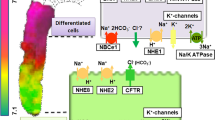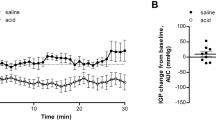Abstract
The duodenal epithelium secretes bicarbonate at higher rates than does the stomach (or more distal small intestine) and the duodenal secretion is currently accepted as the most important defence mechanism against acid discharged from the stomach. HCO3 - entering the continuous layer of visco-elastic mucus gel on top of the epithelial surface maintains pH in its cell-facing portion at neutrality at acidities encountered in the healthy duodenum. The secretion is decreased in patients with acute and chronic duodenal ulcer disease and is inhibited by non-steroidal anti-inflammatory agents. Studies of the neurohumoral control of the duodenal alkaline secretion and of acid/base transport processes and intracellular signaling in duodenal enterocytes are currently of great research interest.
Similar content being viewed by others
REFERENCES
Ainsworth, M. A., Koss, M. A., Hogan, D. L., et al. (1995). Higher proximal duodenal mucosal bicarbonate secretion is independent of Brunner's glands in rats and rabbits, Gastroenterology 109, 1160–1166.
Clarke, L. L. and Harline, M. C. (1998). Dual role of CFTR in cAMP-stimulated HCO -3 secretion across murine duodenum, Am. J. Physiol. 274, G718–G726.
Flemström G. (1994). Gastric and duodenal mucosal bicarbonate secretion, in: Physiology of the Gastrointestinal Tract, 3rd edn, L. R. Johnson (Ed.), pp. 1285–1309. Raven, New York, NY.
Flemström, G. and Isenberg, J. I. (2001). Gastroduodenal mucosal alkaline secretion and mucosal protection, News Physiol. Sci. 16, 23–28.
Flemström, G. and Kivilaakso, E. (1983). Demonstration of a pH-gradient at the luminal surface of rat duodenum and its dependence on mucosal alkaline secretion, Gastroenterology 4, 787–794.
Flemström, G., Hällgren, A., Nylander, O., et al. (1999). Adherent surface mucus gel restricts diffusion of macromolecules in rat duodenum in vivo, Am. J. Physiol. 277, G375–G382.
Hogan, D. L, Rapier, R. C., Dreilinger, et al. (1996). Duodenal bicarbonate secretion: Eradication of Helicobacter pylori and duodenal structure and function in humans, Gastroenterology 110, 705–716.
Holm, M., Johansson, B., Pettersson, A., et al. (1998). Carbon dioxide mediates duodenal mucosal alkaline secretion in response to luminal acidity in the anesthetized rat, Gastroenterology 115, 680–685.
Isenberg, J. I., Ljungström, M., Säfsten, B., et al. (1993). Proximal duodenal enterocyte transport: evidence for Na+-H+ and Cl--HCO -3 exchange and NaHCO3 cotransport, Am. J. Physiol. 265, G677–G685.
Jacob, P., Rossmann, H., Lamprecht, G., et al. (2002). Down-regulated in adenoma mediates apical Cl-/ HCO -3 exchange in rabbit, rat, and human duodenum, Gastroenterology 122, 709–724.
Kaunitz, J. D. and Akiba, Y. (2001). Integrated duodenal protective response to acid, Life Sci. 69, 3073–3083.
Knutson, L., Knutson, T. W. and Flemström, G. (1993). Endogenous dopamine and duodenal bicarbonate secretion in humans, Gastroenterology 104, 1409–1413.
Lönnerholm, G., Knutson, L., Wistrand, P. J., et al. (1989). Carbonic anhydrase in the normal rat stomach and duodenum and after treatment with omeprazole and ranitidine, Acta Physiol. Scand. 136, 253–262.
Malinovskaya, N. K., Komarov, F. I., Rapoport, S. I., et al. (2001). Melatonin production in patients with duodenal ulcer, Neuroendocrin. Lett. 22, 109–117.
Ponomarew, S. J. (1902). Die Physiologie des Brunnerschen Teiles des Zwölffingerdarms. Disserta-tion, St. Petersburg.
Sababi, M., Nilsson, E. and Holm, L. (1995). Mucus and alkali secretion in the rat duodenum: effects of indomethacin, N-omega-nitro-L-arginine,and luminal acid, Gastroenterology 109, 1526–1534.
Säfsten, B. and Flemström, G. (1993). Dopamine and vasoactive intestinal peptide stimulate cyclic adenosine-3′, 5′-monophosphate formation in isolated rat villus and crypt duodenocytes, Acta Physiol. Scand. 149, 67–75.
Seidler, U., Blumenstein, I., Kretz, A., et al. (1997). A functional CFTR protein is required for mouse intestinal cAMP-, cGMP-and Ca (2+)-dependent HCO -3 secretion, J. Physiol. (Lond.) 505, 411–423.
Sjöblom, M., Jedstedt, G. and Flemström, G. (2001). Peripheral melatonin mediates neural stimulation of duodenal mucosal bicarbonate secretion, J. Clin. Invest. 108, 625–633.
Takeuchi, K., Ukawa, H., Kato, et al. (1999). Impaired duodenal bicarbonate secretion and mucosal integrityin mice lacking prostaglandin E-receptor subtype EP3, Gastroenterology 117, 1128–1135.
Rights and permissions
About this article
Cite this article
Flemström, G., Sjöblom, M. Duodenal defence mechanisms: role of mucosal bicarbonate secretion. Inflammopharmacology 10, 327–332 (2002). https://doi.org/10.1163/156856002321544792
Issue Date:
DOI: https://doi.org/10.1163/156856002321544792




